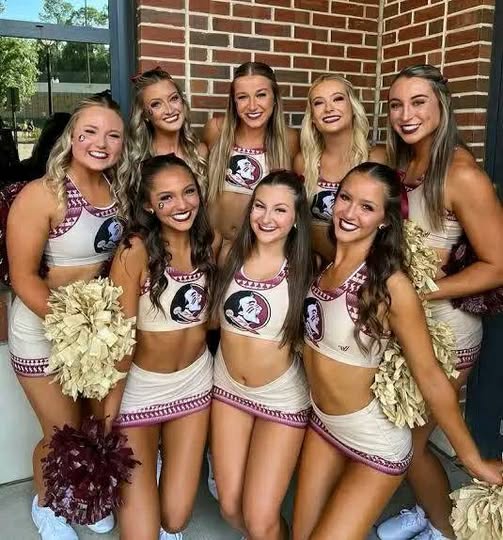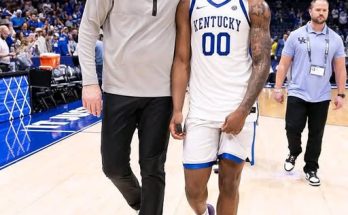In Florida State, a remarkable chapter has just been written in the history of sports, one that doesn’t belong to football, basketball, or any of the traditional giants of college athletics. Instead, it’s the Florida State University cheerleading squad that has stolen the spotlight and captivated the globe. In an announcement that shook the competitive cheer world, ESPN named the FSU cheerleaders the world’s best, a title earned not just through medals and scores but through the spectacle, energy, and innovation they brought to a record-breaking routine that has changed the sport’s global narrative.
This unprecedented recognition came in the wake of the World Cheerleading Championship, where the Florida State squad dazzled an international panel of judges and an audience spanning five continents. Held in Orlando, Florida, the competition featured elite programs from powerhouse nations like the United States, Japan, Canada, and the United Kingdom. Yet, among all the spectacular routines on display, it was Florida State’s groundbreaking performance that stood out as revolutionary. Their routine blended athletic precision with creative risk-taking, balancing high-flying stunts with synchronized dance, jaw-dropping pyramids, and a narrative storytelling technique rarely seen at this level of competition.
Cheerleading, long seen by some as a sideline sport or an auxiliary to football and basketball games, took on a life of its own in this moment. FSU didn’t just cheer; they told a story. The performance opened with an emotional tribute to the evolution of cheerleading, starting with classic moves from the 1970s and 1980s, transitioning through the more competitive styles of the 2000s, and culminating in a fusion of acrobatics, modern hip-hop choreography, and Olympic-level tumbling that left the audience in stunned silence before erupting into standing ovation. The visual and emotional weight of the routine wasn’t lost on anyone watching. It was a performance that could be appreciated even by those who had never understood the sport before.
In the days following the event, ESPN analysts and commentators began dissecting the routine in slow motion, frame by frame, during primetime segments, typically reserved for college football playoff talk or NBA trade rumors. The production quality, the chemistry among the squad members, the synchronization down to fingertip extensions—every aspect was studied like the final seconds of a Super Bowl. Social media platforms like TikTok, Instagram, and X lit up with clips of the routine, some gaining tens of millions of views in a matter of hours. Gymnast Simone Biles reposted the performance, calling it “the most mind-blowing team display of athleticism I’ve ever seen.” Even LeBron James commented on a post, saying, “That’s GOAT-level teamwork.”
The attention didn’t just inflate views and likes; it ignited serious discussions about cheerleading’s place in sports. Pundits on ESPN and CNN Sports debated whether cheerleading, with routines of this complexity, should be included in the Olympic Games. Florida State’s team was no longer just representing a school—they were representing a shift in cultural understanding. Their name became synonymous with what the future of cheerleading could be.
FSU’s head coach, Amanda Colson, who has been with the program for over a decade, was nearly brought to tears during an interview. “We’ve always believed in what cheerleading could become,” she said. “But to be the ones that tip the balance, to be the team that took the leap and succeeded? That’s something I will never forget. These athletes worked through injuries, sacrificed their holidays, and trained harder than ever before. They’ve made history.”
The routine itself was built on the theme “From Sidelines to Center Stage.” According to Colson, the choreography took months to perfect. It included over 150 synchronized movements in less than three minutes, 14 aerial stunts, six unique pyramids, and a synchronized tumbling section involving 18 athletes flipping in unison—something that had never been successfully pulled off in international competition before. The climax involved a double-helix human pyramid, a structure that required precise timing, flawless strength distribution, and total trust among the athletes. The feat took over six months of rigorous practice to master, and its success stunned even veteran judges.
FSU’s triumph comes at a time when the university is increasingly investing in non-traditional sports. Athletic Director Michael Alford noted that this success is no fluke. “We’ve made a conscious decision to treat all of our athletic programs with equal respect and investment. Cheerleading has always been important culturally, but now it’s being recognized competitively, and that’s incredibly validating for the work our athletes and coaches have put in.”
The economic and branding benefits of this victory are already being felt in Tallahassee. FSU merchandise featuring the cheer team’s logo and “World Champions” branding sold out online in less than an hour after ESPN’s announcement. A documentary deal is reportedly in the works with a major streaming platform, aiming to chronicle the behind-the-scenes journey of the team, from early practices to the global stage. Multiple team members have also been approached by endorsement deals, a sign of cheerleading’s growing visibility in the NIL (Name, Image, and Likeness) era.
Beyond the commercial impact, the emotional ripple effect has been even more profound. Young cheerleaders around the world are now citing the FSU squad as their inspiration. High school programs have started redesigning their training regimens to mirror what Florida State is doing. Collegiate cheerleading forums are buzzing with conversations about increasing technical difficulty, innovative storytelling, and greater artistic expression—all trends sparked by one unforgettable routine.
The international cheerleading governing body, ICU (International Cheer Union), released a statement praising FSU for “breaking barriers and redefining the potential of cheerleading.” They also hinted at the development of new scoring metrics and competition categories inspired directly by FSU’s routine. This is perhaps the most significant sign that the sport is evolving, and Florida State is the torchbearer leading it into a new era.
Parents of team members have spoken out with pride, noting how their children are now being recognized as serious athletes. “People used to ask me what my daughter was going to do after college because they thought cheer was a dead-end hobby,” said one parent. “Now, they’re asking how she pulled off that mid-air split in the final stunt of the routine. The respect is finally there.”
And then there’s the intangible impact—the validation for every cheerleader who’s ever been told their sport wasn’t “real,” who’s had to fight for practice time, who’s trained just as hard as football players but received a fraction of the recognition. Florida State’s win is a moment of cultural reclamation, a declaration that cheerleading is no longer just a supporting act. It is a performance of its own, deserving of a headline, a prime slot, and the global respect of athletic audiences.
No one understands this more than the athletes themselves. Senior co-captain Lauren Pierce, in her final year at FSU, summed it up powerfully: “We didn’t set out to be the best in the world—we set out to be better than we were yesterday. But in doing that, we redefined what ‘best in the world’ even means. We’re not just smiling girls with pom-poms. We are athletes. We are performers. And now, finally, the world sees that too.”
Florida State’s cheerleading program has ignited a fire that will be hard to extinguish. Their routine will live on in highlight reels, their name etched into history books, and their message rippling through generations of young athletes: you can change the game, even if the world doesn’t know it’s a game yet.
As the world of competitive cheerleading continues to evolve, Florida State’s squad stands tall—not only as champions but as pioneers, innovators, and artists in motion. What they accomplished goes far beyond trophies. They’ve given cheerleading a new language, a new platform, and a new future. One where the boundaries between sport and art blur, where the sidelines no longer define the space, and where excellence is measured not just in scores, but in the awe you leave behind.



